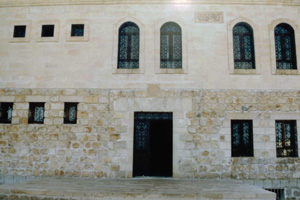We had the first breakfast with the monks after the morning service (not really the first, because after the Easter mess on Sunday they had their first break-fast, and Juhee and Ricardo joined them).

Said
Said, the driver of the bus who brought us almost everywhere, drove us now to Mardin, to say goodbye to Demet, and again buy some food, drink etc.
Amazingly Said managed to pack us and luggage in/on his bus; most of us thought it would not be possible and they were afraid that suitcases would fall of the roof. But as we already saw with the İstanbul cab drivers, it is their job, and they managed.
Up to Midyat and Mor Yakup. Midyat, by now, we knew (we had lunch here on Saturday and the bus driver from Diyarbakır to Deyrulzafaran filled up his tank in Midyat).
Our first stop was again a supermarket where a men start talking to Alite. ‘Did I not met your sister in İstanbul?’ It was George, the contact of Emanuel Shamas in İstanbul that helped Gabriëlle and Alite during the preparation for the Rucksack Turkey project. He was visiting his family in Midyat for Easter.
Before going to Mor Yakup we went to Mor Abraham (in Midyat) to have a look at the (because of Easter) graves; the Suryoye celebrate their ancestors at Easter and have lunch on their graves, unfortunaly we were too late.
We were invited by the monk for a Nescafe. Bassam and Bouchaib had a long talk with the old men and the bishop about the history of Suryoye in the area.
Mor Yakup





Mor Yakup is still under (re)construction and we had a whole floor for ourselves. As brother Johannes told us it is better if you are on your own.
Often Alite had the feeling that the group was alien to their surroundings, not being a Suryoye or a very religious. In the monastery Deyrulzafaran we met a converted Japanese girl and the people of the monastery did respect her because her conviction.
Again we had to share rooms, men/women mix was more relaxed. In Mor Yakup two monks and two nuns are living; they live there for ages and stayed in the area during the tough times.
Mor Yakup is next to the village Salah. Salah was a Suryoye village but now only three Suryoye are living in the village.
The last part of the Rucksack project was planned to work on the personal projects of the students. It was a kind of a turning point in the Rucksack project: everybody was free to make up his own programme and to work on their projects, which was not easy because the impressions of the area where very confusing and contradictionary on the expectations we had after the lectures in Enschede.
Also Demet Varli told us that the conditions in the Tur Abdin area change very fast and at the same time people have to deal with the complex history.
We also noticed that the conception of the people in the diaspora does not always relate to the actual situation. To work on a proposal for a work in such a complex and alien surrounding is not always easy especially when your ordinary work has little connection with the topic. At the end everybody tried their best.
Alite started with a evening session where we could tell the others what we were up and already did, and if we needed help in any way (interpreter, transport). As Said stayed with us, it was easy to arranged trips for dinner, or small excursions to other places.
We were stuck without a interpreter (Demet), but we have our Bassam and Bouchaib who speak Arabic, which was in much cases a good alternative. On the other hand we often met people who could speak a little German, English or Dutch(!!). As being an international group, for Turkey we were not international enough, because none of us spoke Turkish, Kurdish or Suryoye.
For the personal projects of the students follow the link Projects.